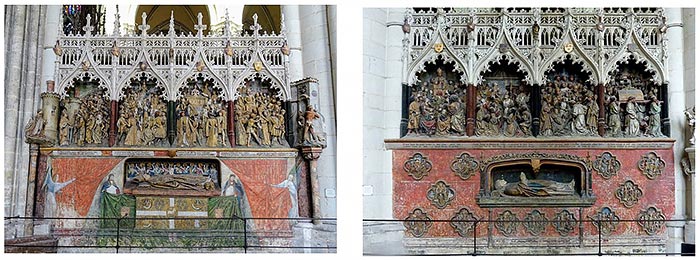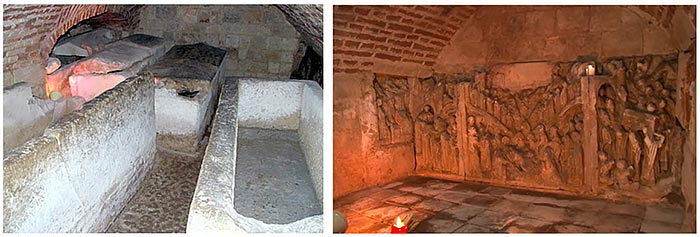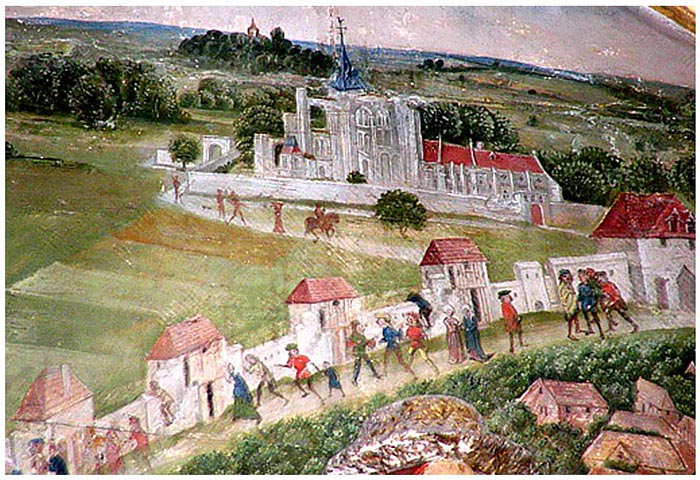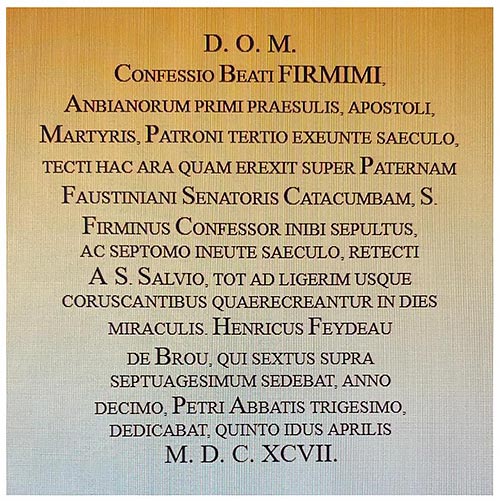June 28
The primitive burial place of Saint Fermin martyr and bishop, apostle of Picardy, at Abladène (Amiens)
José Luis Molins Mugueta
Chair of Navarrese Heritage and Art
Fermín's first activities
In Navarre, the life of its Patron Saint Fermin is popularly known in general terms and is understood to be linked to the Christianization of Pompaelo, in the second half of the 3rd century. The evangelization, first by St. Honesto of Nimes and later by St. Saturnino, bishop of Toulouse, determines the conversion and baptism of Firmo and his family, among them Fermín, as a prelude to multitudinous adhesions to the Christian faith. Then followed the partnership of the young man with Honesto, preaching in the villages of the Pamplona Basin. Later, Fermin's ordination as a priest and then his episcopal consecration by the new bishop, St. Honoratus, involved two trips to the capital of Occitania. Less known among us are some aspects of the life of Saint Fermin and his later cult, which occurred in Gaul, although we know that he died a martyr in Amiens, of whose episcopal see he is considered the first bishop; and that from there, at different times, relics of his have been received, most of them object of cult in the Seo of Pamplona and in the Chapel of his name -in the parish of Saint Lawrence-. The old legal aphorism "the thing cries out for its owner" includes, in the original Latin version, the adverbial condition "ubicumque sit", that is, "wherever it is". And, consequently, understanding that all actions belong to their actor or author, even if the scenarios are different, it is reasonable to try to complement its "international" hagiography.
Bishop
In the public liturgy of episcopal ordination, Honoratus had imposed a condition that Fermín would fulfill scrupulously. It was to exercise the functions proper to a bishop, especially the apostolate, "throughout the length and breadth of the nations". The concept of 'nation' should not be understood here as equivalent to that of sovereign state, but as referring to a human group of common origin, with shared culture and customs, settled in a certain territory, in the agitated moment under the Roman Empire. In reality, Fermin was conferred a missionary episcopate rather than a residential see, even though he heads the episcopologiums of the dioceses of Pamplona and Amiens, places of his double birth, to the world and to eternity. On his return to Pompaelo, Fermín took leave of his family, of Honesto and of the Christian community, to immediately cross the Pyrenees and begin his journey through Gaul. A stay of uncertain duration in Aquitaine, specifically in Agen, was followed by a longer stay in Clemont-Ferrand, capital of Auvergne, where he achieved fame for his persuasiveness and brilliant dialectic. He devoted almost two years to preaching in the region of Anjou, collaborating in Angers with his bishop, Auxilius. He learned of the difficulties suffered by Christians in the land of the Belovaks, and went to Beauvais, where the governor Valerius personalizes the persecution. He preached, converted pagans and strengthened the faith of the persecuted, thus attracting the attention of the repressor, who ordered his arrest and repeated flagellations. Martyrdom seemed imminent, but a military mutiny ended Valerius' life and an illness ended that of his successor, Sergius. The Christians released Fermin from prison and he was able to resume preaching to the Bellovaks. Soon after, he goes to Amiens.
According to tradition, the entrance of Saint Fermin in Amiens (Samarobriva Ambianorum) took place on October 10, without the year being recorded. This date is corroborated by the Breviarium Ambiense of 1407, which indicates this annual date as a commemoration of the arrival of the saintly bishop in the city some time before. It is convenient to make an aside to point out that this was one of the three liturgical festivities dedicated to the martyr, coinciding in Amiens and Pamplona. Why commemorate in Pamplona the arrival in Amiens? The explanation is simple and it has to do with the origin and training of the Burgo de San Saturnino. When in 1129 Alfonso I the Battler granted the regional law of Jaca to the Franks who populated the new district, he stipulated, and I translate, that "no man from Navarre, neither member of the clergy, nor military, nor infant, should live among you". It thus guarantees privileges of a diverse economic and social nature for the new settlers of French origin, including their language, customs, traditions, religiosity... The beneficiaries hastened to build the important Gothic parish church dedicated to Saint Saturnin, evangelizer of Occitania; and some time later, also in the same Burgo de San Cernin, in the church of San Lorenzo, twin in style, a medieval chapel dedicated to Saint Fermin, apostle of Picardy. In 1186, Bishop Peter of Paris or Artajona, obtained from his brother of Amiens, Theobald of Heilly, the first relic of the Patron Saint that is known here, a fragment of skull that is preserved in the Cathedral. Don Pedro established the celebration of San Fermín as a double solemnity, comparable to that of the Holy Apostles. In Pamplona, the liturgical commemoration of the entrance of the holy prelate in Amiens was celebrated on October 10 up to and including 1590; but that year, when the resolutions of the recent diocesan Synod were already in print for publication, the aldermen of Pamplona begged the bishop - who was Don Bernardo de Sandoval y Rojas - to change the feast to July, citing the prospect of better weather, the coincidence with the free fair of medieval origin and being the best season for bullfighting. The bishop agreed, suppressed the October celebration and moved it to the 7th day of the seventh month of the year.
And martyr
But let us return to Amiens to accompany Saint Fermin in the last stage of his earthly life. The city has an abundant figurative repertoire that allows the visual contemplation of the episodes that summarize his hagiography, following a chronologically sequenced story, collected in written narratives, of cultured or popular tradition, interspersed with naive legends. Specifically, I am referring to its Cathedral (1220-1288), in whose transept, Closed by wall to the south nave, in two intercolumniations and over the arcosoliums that shelter the recumbent figures of Bishop Ferry de Beauvoir († 1472) and his nephew, Dean Adrien Hénencourt († 1530), there are eight scenes: respectively, four referring to the life of the martyr; and another four, of post mortem matters.... The episodes are limited by quadrangular frames of small columns, surmounted by ogee arches, festooned with lobed caireles. The result of the set is unitary: the first ones were made by 1490; and the sculpture of the second ones -except for the figure of the recumbent and painting work-, contracted in 1527, was finished by 1530. Both were commissioned by Dean Hénencourt. The sculpture, magnificently polychromed and gilded, oscillates between high relief and rounded bulk. The backgrounds, pictorial, represent exterior landscapes or interior environments, depending on the case. The anachronism of types and costumes brings the events of Roman times emotionally close to the Christian perception of around 1500.

Scenes from the life and the finding of the body of Saint Fermin. Transchorus cathedral of Amiens.
First scene. On October 10, the itinerant bishop Fermin, whose fame precedes him, enters the walled enclosure of Amiens through the gate of Beauvais. There he is received, accompanied by relatives and curious people, by the meaning Faustinian, senator in the city and owner of a nearby villa in the countryside, where he lived with his family and servants and from which he ran his farm. The place was known as Abladène, a toponym that, in old French (Á bleu donné), would allude to the specificity of a cereal production, specifically of wheat. It is worth noting the similarity of personalities and method of penetration of Christianity between the Faustinian of Amiens and Firmo of Pompaelo, which is produced through the family.
Second scene. San Fermín dedicates himself intensely to preaching the Gospel and performs some miracles that support his words.
Third scene. The proclamation of the new creed is followed by countless conversions of Ambians and the continuous application of baptisms, which St. Fermin administers in person. And so it happens with Faustinian, his daughter Attilia (in image) and his son, who adopts out of respect the name of the minister of the sacrament. Eventually he will become St. Fermin the Confessor, third bishop of Amiens for four decades.
Scene four. The alarm caused by the activity of St. Fermin in the official world causes the rapid coming from Trier of the governor Sebastian, accompanied by Longulo. The denunciation of the priests of the pagan cult, especially of a certain Auxilius, causes his arrest and trial. The gallant exhibition that the detainee pronounces in his public defense against the threats leads Sebastian to let him go free, for fear of the reaction of the Christians. But secretly he orders the arrest, nocturnal execution and dismemberment of the bishop's body, with dispersion of his remains. Out of the frame and attached to the pillar that interrupts the sequence, in the cathedral back room of Amiens, the martyrdom by decapitation is represented in round bulge, occurred on the night of September 25, perhaps in the year 303. Today is the most important liturgical feast of his cult, the commemoration of the dies natalis of St. Fermin to Glory.
Body and relics
The cruel mandate of Sebastian is partially fulfilled: the senator Faustinian, by then baptized by Fermin, takes possession of his exsanguinated body - by means of a generous bribe to the executioners -, takes it with all respect to his property of Abladène and buries it secretly in the pagan family tomb. Some time later, the bodies of two holy martyrs of B fame in Amiens, Ache and Acheul, were buried there. Already in time of peace for Christianity, the third Amiens prelate, Saint Fermin the Confessor, son of Faustinianus, will accompany them in their rest. But he had previously arranged the construction of a confessio, modality early Christian architectural, central plant and small proportions, which houses the sarcophagus or relics of recognized saint, in this case of his namesake martyr predecessor: it is not a place of masses, but of visit and anniversaries. The effect of the call, as a spiritual beacon, makes Christians want, when the time comes, to be buried near their prototypes of life: this is how burials ad sanctos, "next to the saints", are formed. Such is the case with St. Fermin of Pompaelo, whom ancient texts call the Apostle of Picardy. A church called Nôtre-Dame-des-Martyrs (Our Lady of the Martyrs), later Nôtre-Dame-de-Saint-Acheul, was built next to the confessio or encompassing it. Throughout the centuries, the site has always been a pious reference point, with various religious buildings and uses, of which a brief description will be given below. With the passage of time, the exact location of the burial, but not of the devotion, has been lost. According to the legendary story, the bishop of Amiens Saint Salvius wanted to locate the body of his predecessor martyr Fermin, to lead him to the walled interior of Amiens. Consequently, he preached to his diocesans the convenience of practicing three days of fasting and intense prayer, in order to obtain from the divinity some indication that would avoid useless works of search(Scene five in the trascoro of the cathedral). Indeed, after the mass of that last workshop, a beam or ray of light rests in the place where it is convenient to dig with profit(Scene six), a portent that is also represented, since the XIII century, in the tympanum of the door of San Fermín, of the same cathedral. On January 13, 615, the finding of the body or Invention of the Relics took place in the presence of Bishop Salvio, four prelates from other neighboring dioceses and countless devout crowds. A pleasant perfume, the odor of sanctity, spreads over a vast territory, like a miraculous notice (Scene seven). Then the procession is organized to carry the venerated corpse in procession, carried by six presbyters, within the walls of Amiens, under miraculous circumstances. In plenary session of the Executive Council winter the temperature rises up to Degrees typical of spring or summer, the fields are green and bloom, the trees see their branches bent by the weight of the fruits, and at the passage of the ark-ataud, some sick people -lepers or possessed- recover their corporal or spiritual health(Scene eight). In the liturgical celebration of the cold January, established to commemorate this event, the chapter of the cathedral of Amiense for some time wore the choral habits of summer. It should be noted that the remains of Saints Acheul, Ache and Fermin the Confessor remained in Abladène, awaiting their transfer, which was later.

Sarcophagi and reliefs on the Invention of the Relics. Amiens. Crypt of the church of St. Acheul.
The place considered the first burial place of Saint Fermin Martyr, therefore with the value of a relic, has had the pious memory of the devotees and has suffered the consequences of its geographical status , in a zone of obligatory passage in case of wars, invasions or similar, and of its location, in the vicinity of Amiens, a fortified place of the first order. It was successively the site of the monastic house of Saint-Acheul (1085), promoted as an abbey (1145), integrated into the French Congregation of Saint Geneviève (1637). In 1750 it was severely damaged by a hurricane, forcing a severe reconstruction, which lasted a decade. In 1790, the French Revolution led to the suppression of the abbey, the nationalization of the buildings, the plundering and sale of its property. In 1814, the Society of Jesus partially recovered it as a novitiate and house of training, which since the second half of the 20th century has housed a school. It was affected by bombing during World War II. A parietal painting, preserved in the first scene of the above-mentioned transcoro, represents the abbey of Saint-Acheul, circa 1490, seen from the promenade of the wall of Amiens, about three kilometers away, in a south-easterly direction.

The Abbey of St. Acheul seen from the ramparts of Amiens. Painting c. 1490. Cathedral of Amiens.
Today, the church is the parish church of Saint-Acheul, part of the municipality of Amiens. In August 1696, the first stone of the Chapel of Saint Fermin was laid in Pamplona. Curiously, months later, at that time, the empty sarcophagi that had sheltered the bodies of Saints Fermin (the Martyr and the Confessor), Acheul and Ache, and probably those of Faustinian and his wife Agrippina, as well as some others, were recovered in Amiens. The event happened by chance and in the following way: on January 7, 1697, during the construction of the foundations of a new high altar in the abbey church of Saint-Acheul, the ground collapsed and an unknown ancient crypt came into view, which housed average dozen monolithic stone sarcophagi, some with covers, of the same material, on two sides. The then Bishop of Amiens, Henry Feydeau de Brou, who consecrated the new altar on April 9, ordered the placement of a commemorative slab of finding of what was considered the confessio of St. Fermin, whom - in elegant Latin - he defined as the first Bishop of the Ambienses, Apostle, Martyr and Patron at the end of the third century; also stating that the place had also been the resting place of St. Fermin the Confessor. Currently, a movable slab allows access to the subway chamber, where, in addition to the empty sarcophagi, four scenes of the Invention of the Relics are preserved, attached to the wall, similar in theme, style, technique and date to those existing in the back of the cathedral, on the tomb of Dean Hènencourt. Unfortunately, the same cannot be said about the conservation of these pieces, which, in view of the description of the end of the 17th century, have deteriorated notably in the time that has elapsed, due to adverse conditions.

Testimony of the finding of the Confessio (1697). Amiens. Church of St. Acheul.
